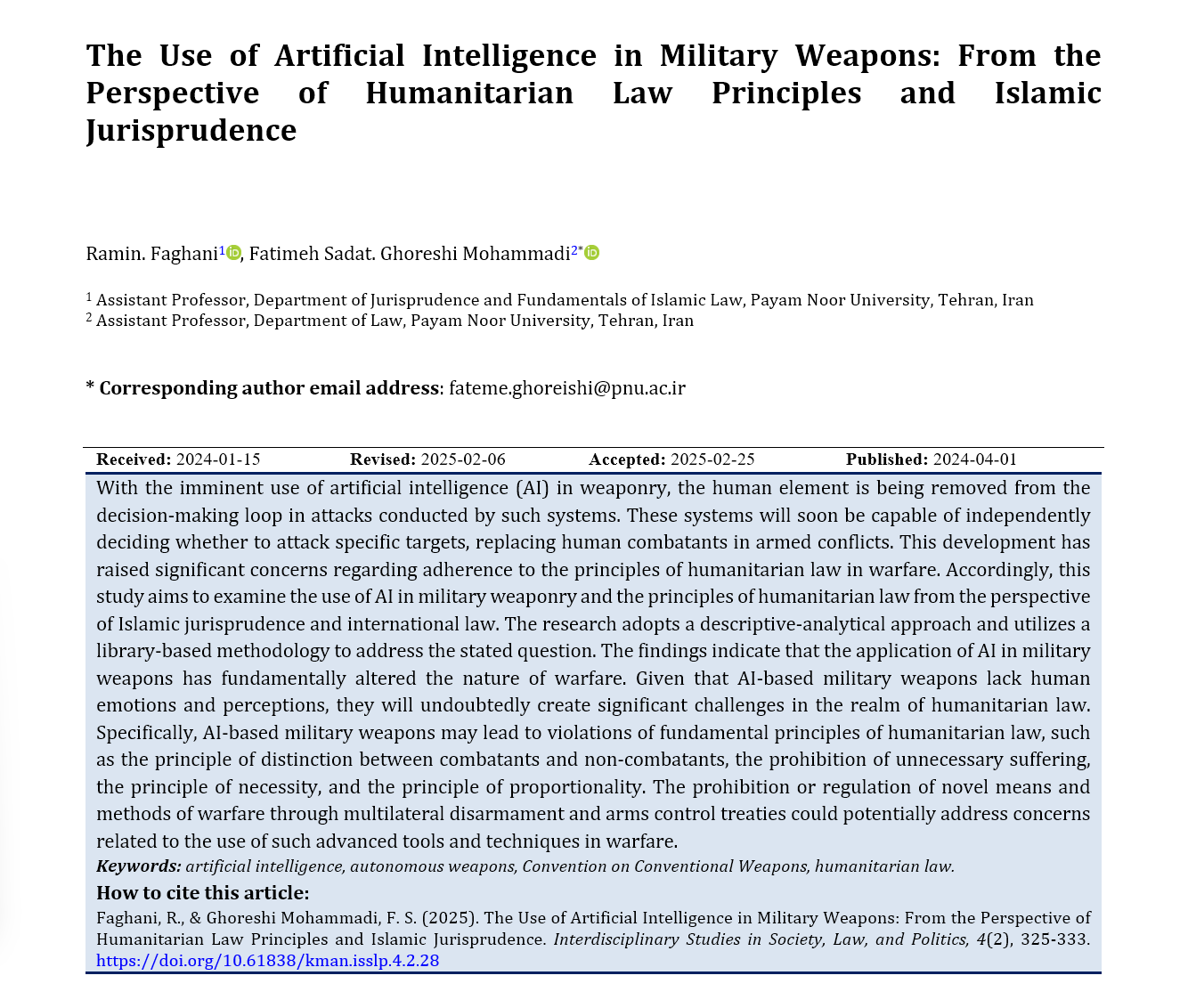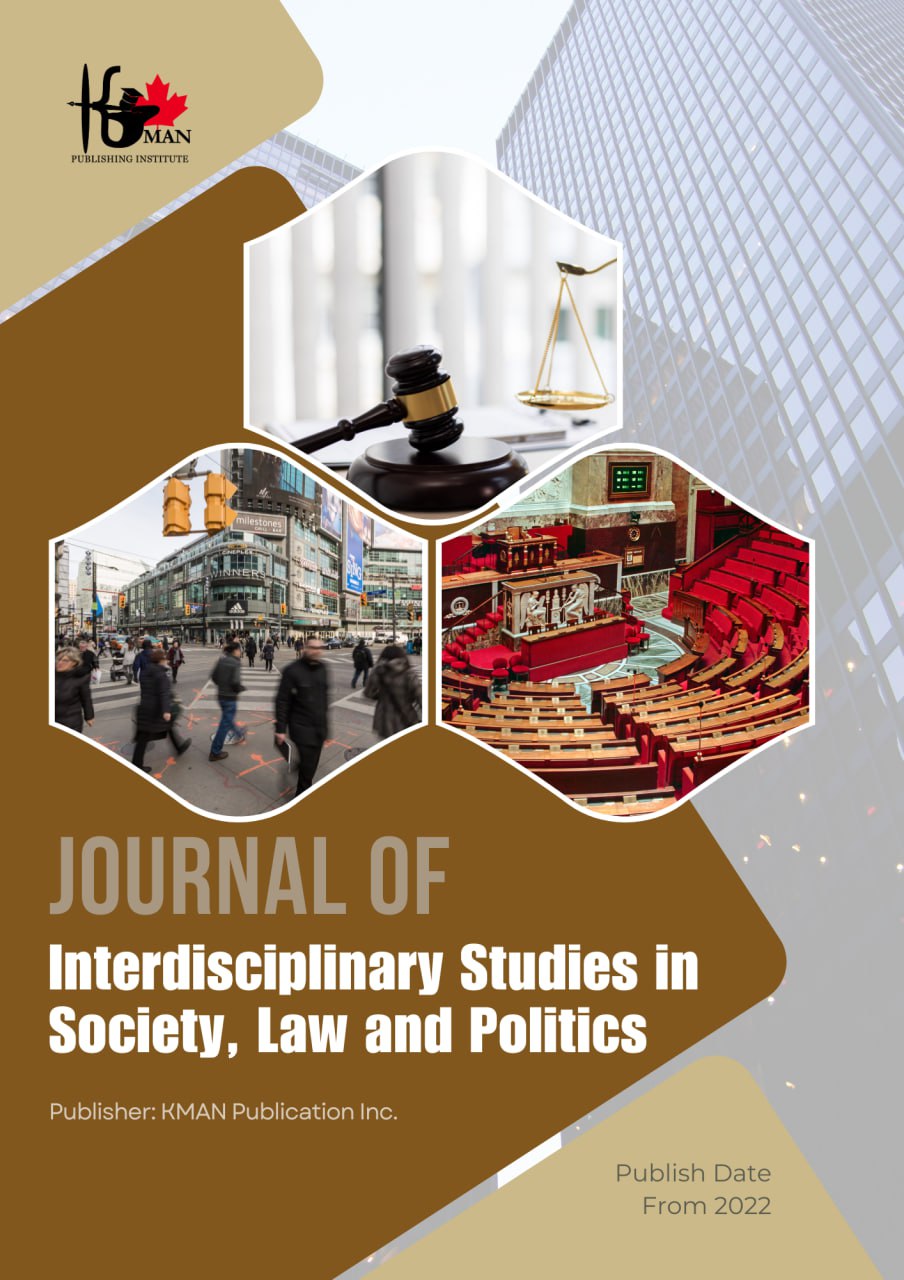The Use of Artificial Intelligence in Military Weapons: From the Perspective of Humanitarian Law Principles and Islamic Jurisprudence
Keywords:
artificial intelligence, autonomous weapons, Convention on Conventional Weapons, humanitarian lawAbstract
With the imminent use of artificial intelligence (AI) in weaponry, the human element is being removed from the decision-making loop in attacks conducted by such systems. These systems will soon be capable of independently deciding whether to attack specific targets, replacing human combatants in armed conflicts. This development has raised significant concerns regarding adherence to the principles of humanitarian law in warfare. Accordingly, this study aims to examine the use of AI in military weaponry and the principles of humanitarian law from the perspective of Islamic jurisprudence and international law. The research adopts a descriptive-analytical approach and utilizes a library-based methodology to address the stated question. The findings indicate that the application of AI in military weapons has fundamentally altered the nature of warfare. Given that AI-based military weapons lack human emotions and perceptions, they will undoubtedly create significant challenges in the realm of humanitarian law. Specifically, AI-based military weapons may lead to violations of fundamental principles of humanitarian law, such as the principle of distinction between combatants and non-combatants, the prohibition of unnecessary suffering, the principle of necessity, and the principle of proportionality. The prohibition or regulation of novel means and methods of warfare through multilateral disarmament and arms control treaties could potentially address concerns related to the use of such advanced tools and techniques in warfare.
Downloads
References
Abbasi, M. (2010). Humanitarian Law. Research Security Quarterly, 3(29), 13-23.
Aboul-Wafa, A. (2000). The Declaration of Rules of International Law and International Relations in Islamic Sharia (Vol. 10). Dar Al-Nahda Al-Arabiya.
Al-Zuhaili, W. (1991). Islamic Jurisprudence and Its Evidence (Vol. 8). Dar Al-Fikr.
Alaie Fard, S., Ansari Mehiyari, A., & Raei Dehghi, M. (2025). The Principle of Proportionality in Light of Artificial Intelligence in Armed Conflicts. Journal of Legal Studies on Cyberspace(9), 35-44.
Amid Zanjani, A. (2004). Political Jurisprudence (Vol. 5). Amir Kabir Publishing.
Amir-Arjmand, A. (1999). Teaching Human Rights. Legal Research Journal, 1(25-26), 29-35.
Azizi Basati, M., & Sokouti, M. (2013). Examining the Impact of Automated Weapons on International Peace and Security. Foreign Policy Quarterly, 29(7), 35-56.
Bhuta, N. (2016). Autonomous Weapons Systems Law Ethics Policy. Cambridge University Press.
Doebbler, C. F. J. (2005). Introduction To International Humanitarian Law. CD publishing.
Eithari Kasemi, A. (2009). The United Nations: Public Information Department (The UN in Today's World). Abaroun Publications.
Eslami, R., & Ansari, N. (2017). The Use of Military Robots in Warfare in Light of Humanitarian Law Principles. International Law Journal, 34(56), 141-164.
Ghaemi Nia, A. (2006). Religion and Artificial Intelligence. Journal of Mind, 7(25), 23-36.
Giacca, A. L. (2015). Robot-Wars: the Regulation of Robotic Weapons. Oxford Martin School at the University of Oxford.
Hakimzadeh Khoyee, P., & Drougari, R. (2023). The Role of Artificial Intelligence in Armed Conflicts and Its Legal Implications. Conference on the Impact of Science and New Technologies on International Peace and Security (Iranian Association for UN Studies),
Hurr Amili, M. b. H. (1991). Wasa'il al-Shi'a ila Tahsil Masa'il al-Shari'a. Dar Ihya al-Turath al-Arabi.
Jafari, S. A. (2012). Analysis of Prohibited Tools and Methods in War from the Perspective of Islam and International Humanitarian Law. Center for Political and International Studies.
Jafari, S. A. (2017). Principles of International Humanitarian Law from the Perspective of Imam Khomeini. Journal of Public Law Studies, 74(2), 754-799.
Khomeini, R. (2008). Sahifeh of Imam Khomeini. Institute for Compilation and Publication of Imam Khomeini's Works.
Majlisi, M. B. (1983). Bihar al-Anwar. Al-Wafa Institute.
Matti, D., Ekenel, H. K., & Thiran, J. P. (2017). Combining LiDAR space clustering and convolutional neural networks for pedestrian detection. 14th IEEE International Conference on Advanced Video and Signal Based Surveillance (AVSS),
Momtaz, J., & Ranjbarian, A. (2005). International Humanitarian Law (Internal Armed Conflicts). Mizan Publications.
Moshbeki, A. A. (2000). Introduction to Artificial Intelligence and Its Applications in Industries. Management Development Journal, 5(13), 30-35.
Movahedi, H. (2007). Establishment of the Islamic Humanitarian Law Committee. Internal Journal of the Bar Association, 3(5), 193-208.
Najafi, M. H. (1989). Jawahir al-Kalam fi Sharh Shara'i al-Islam. Dar Ihya al-Turath al-Arabi.
Russell, S., & Norvig, P. (2003). Artificial Intelligence: A Modern Approach. Publisher Upper Saddle River.
Scharre, P. (2018). Army Of None Autonomous Weapons And The Future Of War. Norton.
Schmitt, M. N. (2013). Autonomous Weapons Systems and International Humanitarian Law: A Reply to the Critics. Harvard University Press. https://doi.org/10.2139/ssrn.2184826
Sharifi-Tarazkouhi, H. (1996). The Law of War. Imam Hossein University Press.
Tabatabai, S. M. H. (1991). Tafsir al-Mizan (Vol. 2). Islamic Publishing Institute.
Treder, M. (2014). Robotic War Appears Inevitable. http://ieet.org/index.php/IEET/more/treder20090327
Ziaei Bigdeli, M. R. (2004). An Overview of International Responsibility for Violations of Human Rights and Humanitarian Law. Journal of Legal and Political Research, 3(13), 18-23.
Ziaei Bigdeli, M. R., & Hosseini, S. A. (2008). Afghanistan's Responsibility for Actions by Jihadi Forces and the Taliban. Journal of Law and Politics, 10(25), 77-85.

Downloads
Additional Files
Published
Submitted
Revised
Accepted
Issue
Section
License
Copyright (c) 2025 Ramin Faghani (Author); Fatimeh Sadat Ghoreshi Mohammadi (Corresponding author)

This work is licensed under a Creative Commons Attribution-NonCommercial 4.0 International License.





